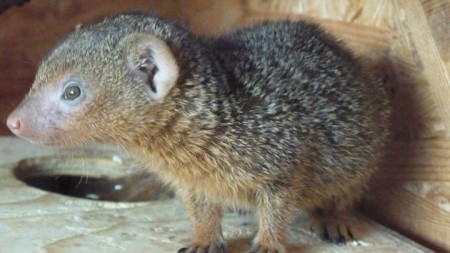| Latin Name | Helogale parvula |
| Conservation Status | Least Concern |
| Location | East & Southern Africa |
| Colour | Brown |
| Length | 18 - 28 cm (7 - 11 inches) |
| Tail | 14 - 19 cm (5.5 - 7.5 inches) |
| Weight | 200 - 350 g (7 - 13 oz) |
| Life Expectancy | 8 Yrs |
Main Characteristics
The Dwarf Mongoose is the smallest African mongoose. They have a body length between 18 and 28 cms (7 - 11 inches), a tail length between 14 and 19 cms (5.5 - 7.5 inches) and they weigh between 200 and 350 g (7 - 13 oz).
They have short, thick brown fur which is finely grizzled with either red or black. They have small eyes and ears on a small head. Their muzzle is short and pointed, they have short legs and long claws on their front feet.
Unlike larger species of mongoose, they do not band together when they feel threatened. Instead they let out a warning cry and run to safety. However, if the young are being threatened, especially by the slender mongoose, they will band together and try and warn off the potentialpredator.
Habitat
Dwarf Mongoose are found in the grasslands, woodlands, brush lands and scrub of east and southern Africa. They can be found at altitudes up to 2,000 m (6,560 ft) and they are common in areas that have many termite mounds.
They live in groups of 2 - 20 individuals and they consist of a dominant pair, their offspring and several sub-ordinate males and females. The dominant female is the leader of the group while the male often observes their surroundings for signs of a threat.
The group inhabit a burrow and they often make use of a termite mound for this. Nearby they will make a communal latrine for both urine and faeces.
Dwarf Mongoose have a small home range that they mark with secretions from their anal and cheek glands. Within this range they will have many dens that they can run to for safety. Sometimes a home range can overlap slightly with that of another group and this can lead to confrontation between the two groups.
Diet
The Dwarf Mongoose feeds upon insects, snakes, lizards, birds, rodents fruit and eggs.
Breeding
Dwarf Mongoose may breed 2 - 3 times per year, usually during the rainy season between October and May. Only the dominant female breeds and after a gestation period of 49 - 56 days up to 6 young are born in a den.
All members of the pack care for the young and they are weaned when they are around 45 days old. They are able to go out with the group by the time they reach 6 months old and they reach sexual maturity at 3 years old.
They are mature enough to breed before 3 years of age, but social pressure prevents them from doing so.
Predators
Predators of the Dwarf Mongoose include birds of prey, snakes and other larger predators.
Subspecies
There are 3 subspecies of the Dwarf Mongoose:
Helogale parvula parvula
They can be found in Southern Africa.
Helogale parvula undulata
They can be found in north east and eastern Africa.
Helogale parvula varia
They can be found in central Africa.
Interesting Facts
Dwarf Mongoose are also known as:
Common Dwarf Mongoose

